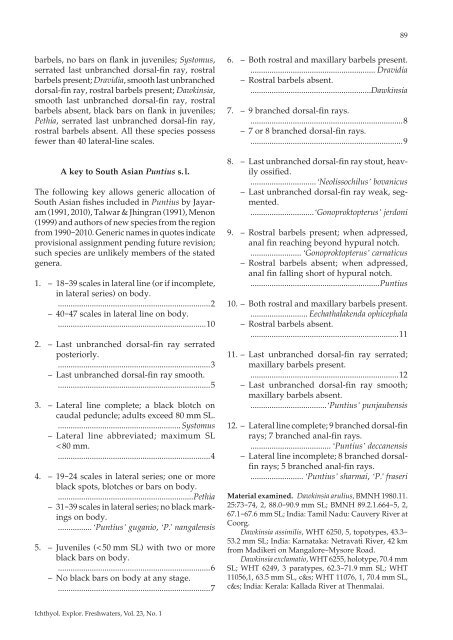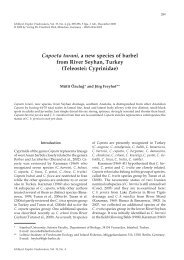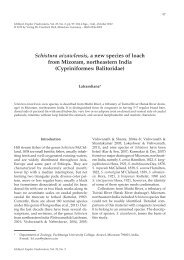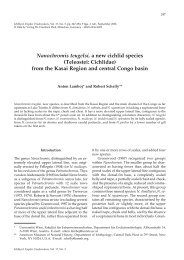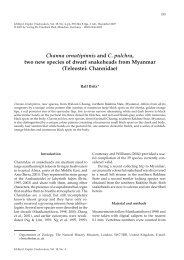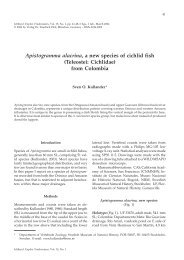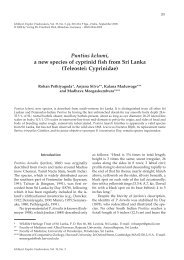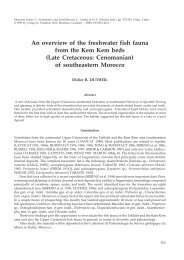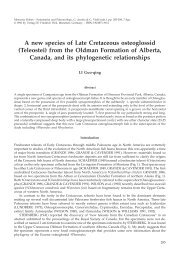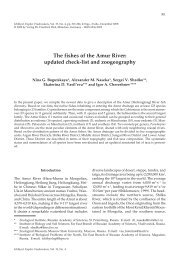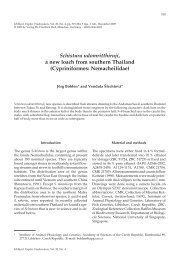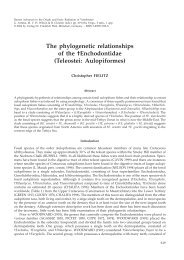A synopsis of the South Asian fishes referred to Puntius - Verlag Dr ...
A synopsis of the South Asian fishes referred to Puntius - Verlag Dr ...
A synopsis of the South Asian fishes referred to Puntius - Verlag Dr ...
You also want an ePaper? Increase the reach of your titles
YUMPU automatically turns print PDFs into web optimized ePapers that Google loves.
arbels, no bars on flank in juveniles; Sys<strong>to</strong>mus,<br />
serrated last unbranched dorsal-fin ray, rostral<br />
barbels present; <strong>Dr</strong>avidia, smooth last unbranched<br />
dorsal-fin ray, rostral barbels present; Dawkinsia,<br />
smooth last unbranched dorsal-fin ray, rostral<br />
barbels absent, black bars on flank in juveniles;<br />
Pethia, serrated last unbranched dorsal-fin ray,<br />
rostral barbels absent. All <strong>the</strong>se species possess<br />
fewer than 40 lateral-line scales.<br />
A key <strong>to</strong> <strong>South</strong> <strong>Asian</strong> <strong>Puntius</strong> s. l.<br />
The following key allows generic allocation <strong>of</strong><br />
<strong>South</strong> <strong>Asian</strong> <strong>fishes</strong> included in <strong>Puntius</strong> by Jayaram<br />
(1991, 2010), Talwar & Jhingran (1991), Menon<br />
(1999) and authors <strong>of</strong> new species from <strong>the</strong> region<br />
from 1990-2010. Generic names in quotes indicate<br />
provisional assignment pending future revision;<br />
such species are unlikely members <strong>of</strong> <strong>the</strong> stated<br />
genera.<br />
1. – 18-39 scales in lateral line (or if incomplete,<br />
in lateral series) on body.<br />
........................................................................2<br />
– 40-47 scales in lateral line on body.<br />
......................................................................10<br />
2. – Last unbranched dorsal-fin ray serrated<br />
posteriorly.<br />
........................................................................3<br />
– Last unbranched dorsal-fin ray smooth.<br />
........................................................................5<br />
3. – Lateral line complete; a black blotch on<br />
caudal peduncle; adults exceed 80 mm SL.<br />
.......................................................... Sys<strong>to</strong>mus<br />
– Lateral line abbreviated; maximum SL<br />
< 80 mm.<br />
........................................................................4<br />
4. – 19-24 scales in lateral series; one or more<br />
black spots, blotches or bars on body.<br />
................................................................Pethia<br />
– 31-39 scales in lateral series; no black markings<br />
on body.<br />
................‘<strong>Puntius</strong>’ guganio, ‘P.’ nangalensis<br />
5. – Juveniles (< 50 mm SL) with two or more<br />
black bars on body.<br />
........................................................................6<br />
– No black bars on body at any stage.<br />
........................................................................7<br />
Ichthyol. Explor. Freshwaters, Vol. 23, No. 1<br />
89<br />
6. – Both rostral and maxillary barbels present.<br />
........................................................... <strong>Dr</strong>avidia<br />
– Rostral barbels absent.<br />
.........................................................Dawkinsia<br />
7. – 9 branched dorsal-fin rays.<br />
........................................................................8<br />
– 7 or 8 branched dorsal-fin rays.<br />
........................................................................9<br />
8. – Last unbranched dorsal-fin ray s<strong>to</strong>ut, heavily<br />
ossified.<br />
...............................‘Neolissochilus’ bovanicus<br />
– Last unbranched dorsal-fin ray weak, segmented.<br />
..............................‘Gonoprok<strong>to</strong>pterus’ jerdoni<br />
9. – Rostral barbels present; when adpressed,<br />
anal fin reaching beyond hypural notch.<br />
........................ ‘Gonoprok<strong>to</strong>pterus’ carnaticus<br />
– Rostral barbels absent; when adpressed,<br />
anal fin falling short <strong>of</strong> hypural notch.<br />
.............................................................<strong>Puntius</strong><br />
10. – Both rostral and maxillary barbels present.<br />
........................... Eechathalakenda ophicephala<br />
– Rostral barbels absent.<br />
......................................................................11<br />
11. – Last unbranched dorsal-fin ray serrated;<br />
maxillary barbels present.<br />
......................................................................12<br />
– Last unbranched dorsal-fin ray smooth;<br />
maxillary barbels absent.<br />
....................................‘<strong>Puntius</strong>’ punjaubensis<br />
12. – Lateral line complete; 9 branched dorsal-fin<br />
rays; 7 branched anal-fin rays.<br />
...................................... ‘<strong>Puntius</strong>’ deccanensis<br />
– Lateral line incomplete; 8 branched dorsalfin<br />
rays; 5 branched anal-fin rays.<br />
......................... ‘<strong>Puntius</strong>’ sharmai, ‘P.’ fraseri<br />
Material examined. Dawkinsia arulius, BMNH 1980.11.<br />
25:73-74, 2, 88.0-90.9 mm SL; BMNH 89.2.1.664-5, 2,<br />
67.1-67.6 mm SL; India: Tamil Nadu: Cauvery River at<br />
Coorg.<br />
Dawkinsia assimilis, WHT 6250, 5, <strong>to</strong>potypes, 43.3-<br />
53.2 mm SL; India: Karnataka: Netravati River, 42 km<br />
from Madikeri on Mangalore-Mysore Road.<br />
Dawkinsia exclamatio, WHT 6255, holotype, 70.4 mm<br />
SL; WHT 6249, 3 paratypes, 62.3-71.9 mm SL; WHT<br />
11056,1, 63.5 mm SL, c&s; WHT 11076, 1, 70.4 mm SL,<br />
c&s; India: Kerala: Kallada River at Thenmalai.


